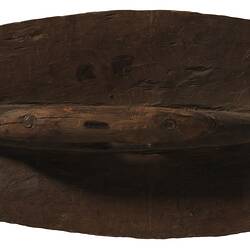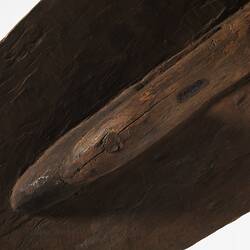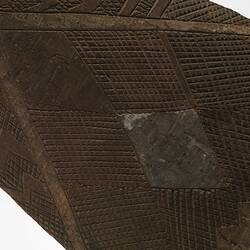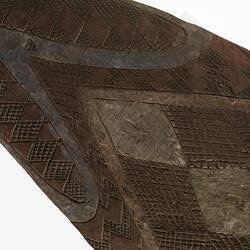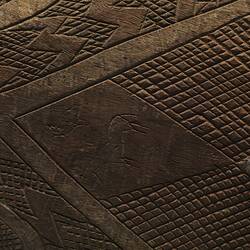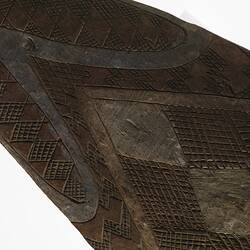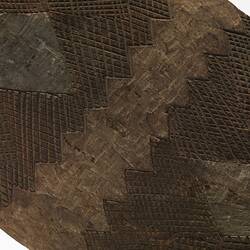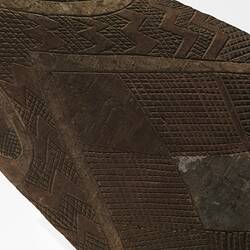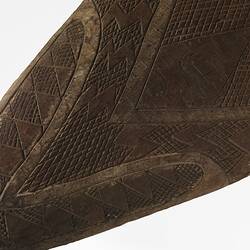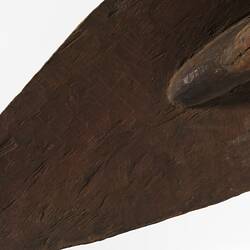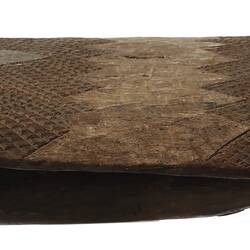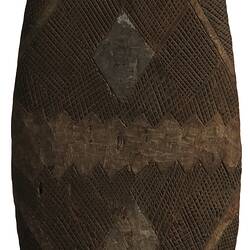Summary
This gee-am (spear shield) features a unique combination of a complex pattern of traditional linear and geometric designs, with finely incised cross-hatching engraved on its surface. It also features a small, delicately carved horse on one of its three engraved diamonds. The addition of a horse on this Gee-am is an important historical record of the arrival of these animals onto the land of the man who carved it.
Intricate designs in wood have been a characteristic feature of the artistic culture of south-eastern Australian Aboriginal men for countless generations. The elaborately incised and ochre designs are a visual language which identified the maker, his clan and country. The arrival of Europeans wrought many changes to their Country and these skilled Aboriginal artists recorded these events on their wooden implements.
This gee-am was from a collection of Aboriginal cultural artefacts which were taken overseas in the colonial era and were returned to Australia in 1995 as part of a bequest. Because of problematic collection practices during these times the name of its maker and the Nation they belonged to was not recorded, leaving us with only a broad, nonspecific area noted as its provenance.
Local Name
Gee-am or Kerreem
Physical Description
Elliptical shaped shield with a diamond shaped point at either end. Convex in cross-section. Posterior surface has been coated with red ochre; handle carved from solid and protrudes from surface. Anterior surface decorated with finely incised cross-hatch pattern; three diamonds painted in grey pigment and a central zig zag band painted in white ochre.
Significance
European animals have long been incorporated into many aspects of Aboriginal culture, both as subjects and for use as materials for making goods, particularly where the introduced animal has depleted the numbers of animals traditionally used to make items. An example of such incorporation can be seen across Central Australia where Aboriginal communities incorporated rabbit tails into waist, head, neck and arm ornaments to replace those of the bilby and bandicoot as they faced extinction due to the introduction of rabbits.
Also important to note is the fact that the workforce of the pastoral industry was largely made up of Aboriginal people who quickly became skilled horsemen and women. Horses and cattle became a large part of many Aboriginal people's lives as they lived and worked on cattle stations and therefore iconography associated with this industry was incorporated into cultural life, including art practice.
Ngarinyman/Ngaliwurru senior law and culture man and artist Alan Griffiths is an excellent example of contemporary Aboriginal artists who simultaneously tell stories through art which have been told for thousands of generations while incorporating the stories of their lives working on cattle stations and depicting the animals synonymous with this life such as horses and cattle.
Alan's Griffith's son Chris, a Miriwoong/ Narinyman man, explains that Aboriginal people were an integral part of the cattle industry from its very beginnings in Australia;
'It is important for all of us to know what it was like for Aboriginal people during this time in Australia's history, in the early years of the white man's invasion into our Country. At first many Aboriginal people were forced onto stations in order to survive, as they witnessed their own countryman die at the hands of the white man. But soon our old people became the backbone of the cattle industry'. Chris Griffiths, 2015.
More Information
-
Object/Medium
Shield
-
Maker
-
Locality
-
Date Produced
-
Collector
-
Object Measurements
820 mm (Length), 210 mm (Width), 70 mm (Height)
-
Classification
-
Date Made
-
Maker
-
Clan/Language Group
-
Place Made
-
Indigenous Region
-
Keywords
-
Collection Names
-
Type of item
-
Discipline
-
Category
-
Collecting Areas

